It’s time to print your own things now. You’re past the paper stage. You have designs, you’re following inspiration. All you need is the right 3D printer to materialize those dreams into reality.
To help you reach your goal, we’ve rounded up the ten best 3D printers and reviewed them here. We’ll talk about important features like print volume size, resolution, filament types, connectivity, and whether a printer is easy to use.
Similar to these ten 3D printers, this is a comparison of two other popular 3D printers.
Whether you’re prototyping a robot, printing tools or designing toys, we want you to get the best 3D printer for your money. Let’s begin our review with a quick chart of the top 3D printer models we selected.
| 3D Printer | Pros | Cons | |
|---|---|---|---|
| Lulzbot TAZ 6 | • Supports over 30 kinds of 3mm filaments including decorative ones • Modular design, swappable print head • Large print volume of 1190 inches • Heated print bed with PEI surface to secure prints • Compatible with most computers • Open source hardware and software | • No internet connectivity | Check Price |
| Lulzbot Mini | • Supports over 30 kinds of 3mm filaments including decorative ones • Modular design, swappable print head • Heated print bed with PEI surface to secure prints • Compatible with most computers • Open source hardware and software | • No internet connectivity • Small print volume • Noisy | Check Price |
| Ultimaker 3 | • Very accurate, high resolution prints from the dual extruders, down to 20 micron layers • Large print volume • Compatible with Windows, Mac, Linux, and mobile platforms • Uses Cura printing software • Wi-Fi connectivity and camera let you watch prints as they happen, and start prints from your smartphone, tablet, or PC | • Very slow print speed at high resolutions | Check Price |
| MakerBot Replicator+ | • Large print volume • Multiple connectivity options like USB, Ethernet, and Wi-Fi • 6th generation model with many upgrades • Print bed has grip texture so you don’t need glue • Mobile app • Accepts native CAD files without conversion | • No warranty, but you can purchase a MakerBot Care Protection Plan • Uses proprietary filament | Check Price |
| Dremel Digilab 3D20 | • Safe design, enclosed, can leave it working overnight without fear of starting a fire • Uses non-toxic, plant-derived PLA filament • Lighted interior lets you watch the printer at work inside the enclosure • Comes with easy to use software | • Only prints with Dremel’s own PLA filament • Average-size build volume | Check Price |
| FlashForge 3d Printer Creator Pro | • Completely enclosed for safety and thermal consistency • Prints with 1.75mm PLA or ABS • Comes with proprietary FlashPrint software • Accepts STL and gcode files • 100 micron print resolution | • Some assembly required | Check Price |
| QIDI TECHNOLOGY 3DP-QDA16-01 | • Prints 1.75mm ABS or PLA • Enclosed print bed • Average size build volume • 100 micron print resolution | • Some assembly required | Check Price |
| XYZprinting da Vinci mini | • Comes with easy to use modeling and printing software plus a gallery of object files to print • Prints with non-toxic PLA • Wireless connectivity and simple print setup • Automatic bed leveling and extruder calibration | • Limited to XYZprinting’s own brand of filament • Small build volume of 5.9 x 5.9 x 5.9 inches | Check Price |
| Monoprice Maker Select 3D Printer v2 | • Better than average print volume • Prints with PLA, ABS, and a variety of other filaments • Compatible with various printing programs and computing platforms • Arrives pre-assembled, very little setup needed • Can print upgrades and replacement parts for it • 1-year replacement warranty | • Manual bed leveling | Check Price |
| Monoprice Select Mini | • Small build volume means it takes up little space on a desktop • 100 micron resolution • Prints almost any kind of filament • Comes pre-assembled • Compatible with a wide range of printing software • 1-year replacement warranty | • Manual bed leveling | Check Price |
Now that you’ve seen the overview of the 3D printers in our article today, let’s discuss what features can help you narrow down the selection.
Features of the best 3D printers
If you’re new to 3D printing, the features discussed in reviews below might need a little explanation. Let’s see if we can help.
Print volume, or what size objects you can print
Print volume is how big of a space the printer can fill with a printed object. It takes into account three measurements: length, width, and height. The total might be stated as a cubic volume.
A good rule of thumb is to buy a printer with a larger print volume than you anticipate needing, if you can afford it. Although you might only want to print cell phone covers now, you may want to prototype gears for an all-terrain robot next year.
Resolution, or how smooth your objects will look
Just like on a paper printer, a 3D draft print is a quick reproduction that doesn’t have high resolution or smooth edges. Sometimes you’ll only want a rough print like that, but sometimes you’ll need an object to be as smooth as possible.
Resolution varies quite a bit between 3D printers. Generally, higher resolutions take a lot longer to print. In fact, reducing the layer thickness by one half will often double the time it takes to print.
Layer thickness is measured in microns, with one micron being 0.001mm. Most 3D printers can print at 200 microns, and many down to 100 microns. Some, like the Ultimaker 3, can print 20 micron-thick layers, resulting in very smooth finishes on objects.
Filaments, or what materials you can use for printing
Most printers can use either ABS or PLA, or both. ABS doesn’t need a heated print bed, but it outgasses a strong odor when it melts. On the other hand, it’s more flexible than PLA. Meanwhile, PLA-printed objects end up with a smoother texture but are more fragile than those made with ABS.
Artists and artisans may prefer a versatile 3D printer that can extrude, or print with, a variety of filament types. Besides those two common filaments, some 3D printers can handle other materials like UV-luminescent plastics, nylons, polycarbonate, PVA, polyester, high-impact polystyrene (HIPS), and composites with wood, metal, and stone.
There are two other factors that you’ll need to know about filaments. One is the size. The most common sizes are either 1.85mm or 3mm in thickness. The filament comes on a spool that usually sold by its weight, not by the length of the filament on it.
Besides size, you’ll need to determine if the printer you have requires a proprietary filament. Some printer companies will lock you into only using their own brand. Their 3D printers will literally refuse to print with anything else.
Multiple extruders, or if you can print in multiple colors
Some 3D printers have multiple extruders or print heads so they can print in more than one color at once. Or instead, they can print an object with one kind of filament along with a support structure made from a dissolvable filament.
If the ability to print in more than one color appeals to you, look for modular print heads or multiple extruder heads. These save time from having to swap filaments mid-print, if that’s possible with the job you want to do. Just be sure the object file is designed for multi-color printing, too.
Connectivity, or how you can send files to be printed
Most 3D printers let you print from a connection with a computer. Many accept files from an SD card or a USB drive. But more and more are making it possible for you to print over your home network or even from the Internet. If the ability to start a print job when you’re away from home is important to you, shop for a cloud-connected printer. A few models like the Ultimaker 3 have on-board cameras that allow you to check the progress of your job, too.
Ease of use features like automatic print bed leveling
Some 3D printers come ready to use out of the box, others will require quite a few connections and adjustments before you can use them the first time. Some come with nice features like automatic print bed leveling or a textured grip surface for your prints.
While some manufacturers offer mobile apps for controlling their printer, others are limited to a basic LCD screen built into the printer or need a connection to a computer to work.
Take into account your own tolerance for tinkering and how much enthusiasm you have for learning the ins and outs of 3D printing. Then choose a printer that suits your needs and ability.
With that said, here are our top 10 picks of the best 3D printers.
Lulzbot TAZ 6—Best Large Volume 3D Printer for Enthusiasts and Artists
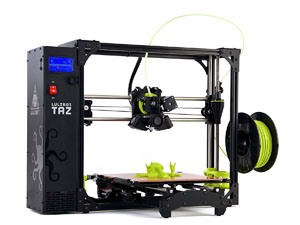
The Lulzbot TAZ 6 is a dream machine for 3D printing enthusiasts. It can handle a wide variety of filament types, it has a large print volume, larger than the Ultimaker 3, and it is both self-leveling and self-cleaning. And since it employs open source Cura software for slicing, it’s compatible with Windows, Mac, and Linux computers.
As for quality and reliability, Lulzbot builds and tests the TAZ 6 at a factory in Colorado. In fact, they use their own printers to create parts for new printers. Owners can also do the same—build new parts and modify the TAZ 6 however they wish since it’s open source hardware.
One of the best features is the wide variety of filaments supported by this printer’s extruder, which heats up to 572 F. At the time of writing, it was possible to print with over 30 materials, including PVA, PLA, ABS, HIPS, nylon, nGen, polycarbonate, and composites with wood, metal, or stone. Lulzbot is always adding new possibilities, too.
Since you can swap print heads with the TAZ6’s modular design, it’s possible to print with two filaments at once. That’s great for filling up the huge print volume space that measures 11.02 x 11.02 x 9.8 inches in size. And the heated PEI print bed helps prints stay put during the process.
The only downside to the TAZ 6 is its lack of internet connectivity. You’ll need to insert and SD card or connect the printer to a computer to start a print.
Features of the Lulzbot TAZ 6:
- Supports over 30 kinds of 3mm filaments
- Modular design, swappable print head
- Large print volume of 1190 inches
- Heated print bed with PEI surface to secure prints
- Comes with built-in quick print profiles
- Covered by 1-year manufacturer warranty
- Compatible with Mac, Windows, and Linux computers
Click here to purchase LulzBot TAZ 6 on Amazon.com!
LulzBot Mini—Small Footprint and Very Versatile for Artists
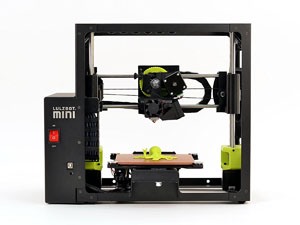
The Lulzbot Mini is reliable and versatile like the TAZ 6, but it comes in a smaller package. The print volume is 6 x 6 x 6.2 inches in size, a little more than half that of its larger sibling. But since the Hexabot hot end print head design is modular, and it reaches up to 572 F, the Mini can print with the same wide range of 3mm filaments.
At the time of writing, the Mini supports printing with more than 30 materials, from ABS to PLA to HIPS, T-Glasem, polycarbonate, and many more, even decorative filaments mixed with stone, metal, or wood. And since the layer height is 0.005mm, or 50 microns, which means high resolution prints come out smooth.
But all this power doesn’t come at the cost of making it difficult for the user. Instead, the Lulzbot Mini does everything to make it simple to get a print started. It does an automatic check of the print bed to make sure it’s level. If it’s not, it levels itself. And the PEI surface on the glass of the heated print bed makes it so you won’t need glue sticks or tape to secure prints.
While the printer comes with the free and open source Cura software for printing, you can also use other programs like MatterControl and OcotPrint. Just make sure the printer is connected to a computer for printing since it doesn’t have Internet connectivity on its own.
The main downside to the Lulzbot Mini is simply the amount of noise it makes while working. When you’re doing a large print, you may want to leave the printer by itself and close the door.
Features of the Lulzbot Mini:
- Prints with a wide range of over 30 kinds of filaments, even decorative ones
- Heated print bed with PEI surface
- Compatible with Mac, Windows, and Linux computers and various print programs
- Covered by a 1-year warranty
Click here to purchase LulzBot Mini on Amazon.com!
Ultimaker 3—For the Highest Resolution and Best Quality Prints in Multiple Colors, Plus You Can Watch the Printer Working over the ‘Net
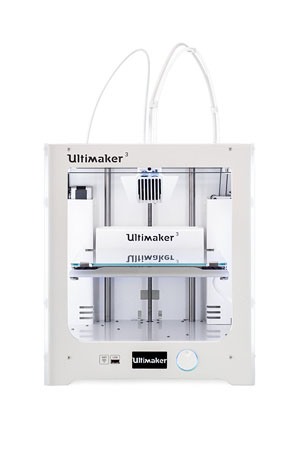
The Ultimaker 3 arrives almost completely ready to go right out of the box. It is very easy to use, even for people new to 3D printing.
While it’s slow, it’s very accurate and reliable. And it makes use of open source Cura software for slicing, so it’s compatible with almost any computer platform.
The print resolution is very good, with high quality down to only 20 microns per layer. At this level, finished prints look very smooth. Even draft prints come out better than drafts from other 3D printers like the Makerbot Replicator+.
As for versatility, the Ultimaker 3 has two swappable extruder heads, or print cores,which allow prints with two colors, or one color with dissolvable supports.The main print head works with various kinds of 3mm filaments likePLA, pVA, ABS, CPE, TPU 95, and nylon. But you’re not restricted to using a particular brand of filament, unlike some 3D printers like XYZprinting’s da Vinci.
If you choose to use filament reels from Ultimaker, they come with NFC chips that talk to the printer. That makes for a nice shortcut in setting up for a print since the printer is aware of what filament is ready to use.
The Ultimaker 3’s extruder reaches a maximum of 536 F and its print bed reaches 212 F. Since the printer has a heated glass bed, you’ll want to use the glue stick that comes in the box, or blue painter’s tape, to secure your prints. As for print size, the total volume is 215 by 215 by 200mm, or 9.84 by 9.84 by 7.87 inches.
And while the Ultimaker 3 is working, you can watch it in action over the Internet, thanks to a camera mounted on the printer’s frame. This is a nice feature to have because it can literally take hours to finish a large print.
The print speed is the only real downside to the Ultimaker 3. High resolution prints appear at a glacial velocity of 30mm/second, while the top speed for draft prints is 300mm/s. But with X and Y-axis precision down to 12.5 microns and Z-axis precision at 2.5 microns, you might be just pleased to sacrifice speed for accuracy.
Features of the Ultimaker 3:
- Compatible with Windows, Mac, Linux—any platform on which Cura software can run
- Printer comes with grease, spool holder, power supply, test print, glue stick, and hex driver tool
- Wi-Fi connectivity lets you watch prints as they happen, and start prints from your smartphone, tablet, or PC
- Very accurate, high resolution prints from the dual extruders, down to 20 micron layers
- Covered by a 1-year manufacturer’s warranty from Ultimaker
Click here to purchase Ultimaker 3 on Amazon.com!
MakerBot Replicator+—Large Build Volume and Excellent Connectivity, Includes Smartphone App
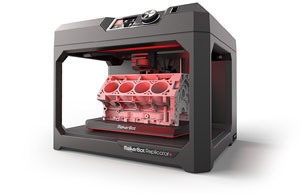
The MakerBot Replicator+ is a 6th-generation 3D printer that benefits from all the previous MakerBot models. It’s faster, it has a larger print volume, a new sturdier gantry, a new print bed surface, and new options for connectivity. If you own a MakerBot already, these improvements might be enough to convince you to upgrade.
Unlike the TAZ 6 from Lulzbot, the Replicator+ has 21st century connectivity thanks to the MakerBot Mobile app and the MakerBot Print software. You can setup and control a print using your smartphone even when you’re not at home. Or you can also use a USB pen drive, send a file over Wi-Fi, Ethernet, or from your computer over a USB cable.
The printer accepts native CAD files without needing to convert them to STL format. The standard print resolution is 200 microns per layer, while high quality goes down to 100 microns. This isn’t as smooth as the Ultimaker 3 can print, but it’s still good. The new flex build plate, or print bed, with its Grip Surface helps reduce warping and curling so prints turn out perfect.
There is just one con to the Replicator+. Since it doesn’t have a heated print bed, you’re limited to PLA filament for printing. And worse, it needs to be MakerBot’s proprietary filament, which can be a bit expensive.
Features of the MakerBot Replicator+:
- No warranty, but you can purchase a MakerBot Care Protection Plan
- Build volume is 11.6 x 7.6 x 6.5 inches
- Multiple connectivity options like USB, Ethernet, and Wi-Fi
- Mobile app
Click here to purchase MakerBot Replicator+ on Amazon.com!
Dremel DigiLab 3D20—Reliable and Safe for Tinkerers of All Ages

The Dremel DigiLab 3D20 looks every inch the professional printing machine. It’s enclosed, it’s durable, it’s easy to use, and it’s safe. The fully-enclosed design keeps the temperature inside consistent so prints don’t warp or curl.
As Dremel points out, the enclosure is also a safety feature to protect children from getting burned. Plus, they have a UL safety certification that lets you leave the printer working overnight without worrying about it overheating and starting a fire. While Dremel offers a one-year warranty, they also offer “infinite” customer support should you have questions.
Setting up a print on the 3D20 is pretty straightforward. Either use a computer, or use the touchscreen to read an SD card or USB thumb drive. Dremel provides their own software for you to use.
Since the build volume is 10 x 6 x 6.7 inches in size, you can print a pretty good variety of objects. The resolution ranges from 4mm down to 100 microns per layer, which is average for this price range of 3D printers.
The downside to the DigiLab 3D20 printer is that Dremel requires that you use only their own brand of 1.75mm PLA filament. But it is non-toxic and recyclable, and it generally prints most objects with a smooth finish.
Features of the Dremel DigiLab 3D20:
• Child-safe design, can be left working overnight without fear of starting a fire
• Uses non-toxic, plant-derived PLA filament
• Lighted interior lets you watch the printer at work inside the enclosure
• 1-year warranty plus infinite customer support
Click here to purchase Dremel DigiLab 3D20 on Amazon.com!
FlashForge 3d Printer Creator Pro—Good Value for Buyers on a Budget
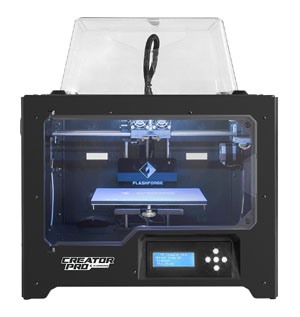
Like MakerBot, FlashForge has had some time to improve their newest 3D printer models. They point out that the 3D Creater Pro is now stronger than ever. Its frame is built from aircraft grade aluminum so it won’t warp from heating and cooling. The z-axis support has also been reinforced to ensure precise movement. And the power supply has been replaced with a more reliable brand. Some assembly is required when you set it up for the first print.
Like the Dremel DigiLab 3D20 and the Ultimaker 3, the 3D Creator Pro is completely enclosed. This is a nice safety feature for persons who have small children around, plus it helps maintain a consistent temperature during printing.
The FlashForge print software is called FlashPrint, and it works on Mac, Windows, and Linux computers. You can use it to print from an SD card or from the computer over a USB connection. It accepts both gcode and STL object files.
But if you’re hoping for very high resolution prints, this may not be the best machine for you. Although it works with both PLA and ABS filaments, the adjustable layer thickness ranges down to 100 microns. It also has an average-size build volume of 8.86 x 5.71 x 6.1 inches.
Features of the FlashForge 3D Printer Creator Pro:
• Manufacturer’s warranty plus lifetime tech support
• Completely enclosed for safety and thermal consistency
• Prints with 1.75mm PLA or ABS
• Comes with proprietary FlashPrint software
• Accepts STL and gcode files
Click here to purchase FlashForge 3D Printer Creator Pro on Amazon.com!
QIDI TECHNOLOGY 3DP-QDA16-01—Good Value Printer for Drafts and Prototyping

You may have noticed or heard that the Flashforge Creator Pro and the QIDI TECH 1 are MakerBot Replicator clones. You can see some similarities in their designs and abilities, like the100micron print resolution. And it comes with 1-inch spool holders that fit almost any brand of filament you might want to use.
The TECH 1 prints with either ABS or PLA filament. You can load files from an SD card or over a USB connection to your computer. The software you’ll use for slicing the object files on the TECH 1 is Simplify 3D. (If you’re a fan of Cura, check out QIDI’s other printer, the TECH X-one.)
Even with dual extruders, this printer only prints one color at a time. Should you wish to upgrade the print head, some owners have had success printing a new one and installing it themselves.
The QIDI TECH 1 is proving itself to be a nice budget investment for those who don’t mind a little more hands-on experience with a 3D printer.
Features of the QIDI Tech 1:
- Prints 1.75mm ABS or PLA
- Enclosed print bed
- 100micron resolution
- Build volume 8.8 x 5.9 x 5.9
Click here to purchase QIDI TECHNOLOGY 3DP-QDA16-01 on Amazon.com!
XYZprinting da Vinci mini—Very Easy to Use for Children and Adults

If you have children who want to do their own 3D printing, the da Vinci mini might be one of the best choices here. It comes with free 3D modeling design software called xyzmaker, free object files to print, and easy to use software for connectivity and printing.
In fact, XYZprinting calls it “single-button” printing, which can be done wirelessly over your home network instead of through a connected computer. The printer calibrates itself, adjusting the extruder and leveling the print bed before each print.
The XYZprinting brand filament, the only kind you can use with this printer, is non-toxic PLA. The manufacturer states that it’s tested to be free of both heavy metals and DEHP.
Features of the XYZprinting da Vinci mini:
- Comes with easy to use modeling and printing software plus a gallery of object files to print
- Prints with non-toxic PLA
- Wireless connectivity and simple print setup
- Automatic bed leveling and extruder calibration
- Small build volume of 5.9 x 5.9 x 5.9 inches
Click here to purchase XYZprinting da Vinci mini on Amazon.com!
Monoprice Maker Select 3D Printer v2—Good for Advanced Users on a Budget
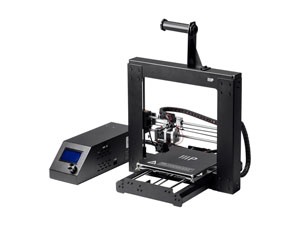
The Monoprice Maker Select 3D Printer v2 strives to balance good quality and features with an accessible price. It has a large print volume of 8 x 8 x 7 inches in size, plus a heated print bed. It’s capable of printing with ABS, PLA, and PLA blends, as well as PET, TPU, HIPS, PVA, FPE, TPC, Foam, Jelly, and Felty.
With this 3D printer, you’re not locked into only one print software. It’s compatible with Cura, Simplify 3D, and Repeater, so it works with Linux, Mac, and Windows computers. But all you really need to print is a micro SD card with sliced GCODE files. Plug that into the printer and you don’t need to connect to a computer.
Another handy feature of the Monoprice printers (this one and the one below) is that they ship pre-assembled. You only need to unpack, tighten a few screws, and turn them on. They come with a 2GB micro SD card that already contains object files to print plus a small sample spool of PLA filament.
If you’re familiar with 3D printers, you may recognize that the Monoprice Maker Select v2 is a rebranded Wanhao Duplicator i3 RepRap printer. This is good news for makers who want to expand the capabilities of their 3D printer or repair them at home. It’s possible to print your own parts for this model.
The main downside to the Maker Select v2 is that you’ll need to level the print bed manually. Some users recommend printing an upgrade that consists of bed spring guides to make this process a lot faster and easier. Features of the Monoprice Maker Select v2:
- Better than average print volume
- 100 micron print resolution
- Prints with PLA, ABS, and a variety of other filaments that don’t need more than 500 F
- Compatible with various printing programs and computing platforms
- Arrives pre-assembled, very little setup needed
- Can print upgrades and replacement parts for it
Click here to purchase Monoprice Maker Select 3D Printer v2 on Amazon.com!
Monoprice Select Mini—Small Footprint and Versatility on a Tight Budget
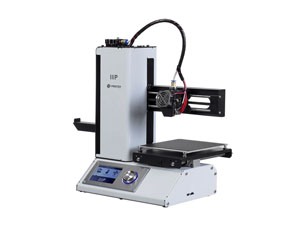
If you want a printer with a small footprint, but much more versatility than the XYZprinting’s da Vinci mini, take a closer look at Monoprice’s Select Mini 3D. Like its larger sibling we reviewed above, the Mini can print with a variety of filaments, from ABS and PLA to PVA and composites.
The Mini also won’t make you wait long to get started after you unpack it. It comes pre-assembled with a small spool of PLA filament and a micro SD card with object files already on it. You can use files from the card itself, or connect a computer to print something else.
This printer doesn’t care if you prefer Cura over Repeater, or any other printing software. It works with any of them. Although it has a small build volume or 4.7 x 4.7 x 4.7 inches, it has a 100 micron resolution, typical for 3D printers in this price range.
The only thing you’ll need to worry about is leveling the print bed. But if you want to streamline this process in the future, print an upgraded part from Thingiverse to make it easier on yourself.
Features of the Monoprice Select Mini 3D Printer:
- Small build volume means it takes up little space on a desktop
- 100 micron resolution
- Prints almost any kind of filament that doesn’t need more than 446 F
- Comes pre-assembled
- Compatible with a wide range of printing software
Click here to purchase Monoprice Select Mini on Amazon.com!
Buyers Guide on how to choose the best 3D printer
Now that you’ve seen our top ten choices for best 3D printers, let’s see if we can help you with the decision you’re about to make.
What’s most important about buying a 3D printer? The most important part is simply choosing one that you will use and enjoy. It sounds simple, but consider these points. You’re going to be investing time in learning how to use it and the software for it. Plus, you’ll be spending quite a bit of time waiting for prints to finish. That’s why it’s essential to select a printer that is matched to your technical abilities and your plans for what you want to print.
To sum up, which is the most important feature for you?
- Build volume, or how big a printed object can be
The 3D printers with the largest build volumes are the Lulzbot TAZ 6, the Ultimaker 3, and the MakerBot Replicator+. Or you may prefer a smaller footprint like the Monoprice mini, the Lulzbot mini, or the da Vinci mini.
- Print resolution, or how smooth the final result will be
The one with the best resolution of all is the Ultimaker 3, down to 20 microns. Average resolution for many home use 3D printers is 100 microns. Check out photos of prints to get an idea of how that appears with common filaments like PLA.
- Materials that can be used for printing
The ones with the widest variety of filament compatibility are the LulzBot TAZ 6 and Mini, and the Monoprice Select Mini and Maker Select v2. Keep in mind that some manufacturers limit your choices to only their brand.
- Single color or multiple color prints
The Ultimaker 3 comes with dual print heads that can print multiple colors right out of the box. Other 3D printers have the ability to swap their extruders, or you can also print one color at a time and switch filaments mid-print.
- Connectivity to transfer files for printing, whether wireless, or through a cable, SD card, or USB drive
The MakerBot Replicator+ has the widest range of connection options. The Ultimaker 3 has a wireless connection plus a built-in camera for watching the print building. The little da Vinci mini also has wireless connectivity.
- Ease of use (pre-assembled, automatic bed leveling, etc.)
Many of the printers in this review come pre-assembled and need little setup before the first print. But some have the additional convenience of automatic print bed leveling and extruder calibration like the XYZprinting da Vinci mini.
In the end, there are many good choices for 3D printers on the market. Consider why you want one and what you plan to do with it. Compare features and prices. And also consider the future.
Future-proof your purchase
Whenever you buy anything electronic or computer-related, you know that the technology will only be cutting edge for a little while. Pretty soon that shiny new 3D printer may be surpassed by newer models with better features.
This problem is exacerbated when you purchase a printer that relies on proprietary software, parts, or filaments. Should that company discontinue that printer or those materials, will you be left with a giant paperweight on your desk?
There are good arguments for going with a proprietary system. Dremel’s DigiLab 3D20 is top of the line in safety and the da Vinci mini is designed for little makers who need easy access to printing. But if those companies shutoff your access to their products, will you be able to upgrade to a new printer?
If you’re concerned about those possibilities, consider getting a 3D printer that you yourself can upgrade, hack, or modify. For example, you can do this to either of the Monoprice printers.
You may find that you enjoy the power of customizing your equipment to be just how you like it. And you’re going to be able to enjoy your 3D printer for much longer if you can repair it yourself.
Conclusion
Once you have your 3D printer, you’ll be inspired by all the amazing things you can do with it. And once you begin visiting all the websites that offer free downloads of OBJ, CAD, STL, and Gcode files, you’ll need to buy a lot more filament!
In fact, when you buy your printer, consider purchasing additional spools right with it. Generally, the samples that come with many printers are only enough for small objects just to demonstrate the printer’s capabilities.
If you happen to find yourself stymied by setup or uncertain about how to slice, there are many resources online that can help. Your own printer’s manufacturer may have FAQs to guide you, plus there are lots of forums, videos, and how-to guides on the Internet.
Some 3D printer owners find that they love working on printing projects. They end up offering their printing services for a fee. That’s a great way to save up for your next printer down the road.
In summary, we hope these reviews and the buyer’s guide help you choose the best 3D printer for your plans and projects in the future.